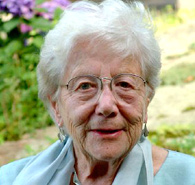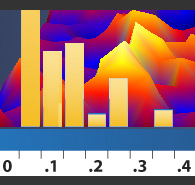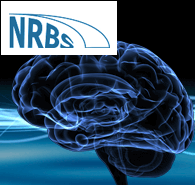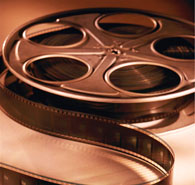by Siegfried Othmer | December 2nd, 2008
 The death of Florence Wald at the age of 91 is a moment to reflect on the extraordinary change she has worked as a pioneer of hospice care. As a Dean of the School of Nursing at Yale, Wald was troubled by the exclusive focus on cures, with little regard for the wishes of the patient or his or her family about ongoing care. She became acquainted with St. Christopher’s, the first hospice in England that was established by pioneer Cicely Saunders. After quitting her position and spending time at St. Christopher’s, she then established the first hospice in the United States in 1971, which in time became the model for hospices everywhere.
The death of Florence Wald at the age of 91 is a moment to reflect on the extraordinary change she has worked as a pioneer of hospice care. As a Dean of the School of Nursing at Yale, Wald was troubled by the exclusive focus on cures, with little regard for the wishes of the patient or his or her family about ongoing care. She became acquainted with St. Christopher’s, the first hospice in England that was established by pioneer Cicely Saunders. After quitting her position and spending time at St. Christopher’s, she then established the first hospice in the United States in 1971, which in time became the model for hospices everywhere.
Wald had a larger vision, however. “Hospice care for the terminally ill is the end piece of how to care for patients from birth on,” she wrote. It is this vision that needs to be carried forward, and that has particular implications for us in neurofeedback. In hospice care we have a more balanced view of the needs of the patient. The focus is on maximizing the quality of life rather than mere avoidance of death. It involves the family fully, and relies on home care as much as possible. In this setting, there is a softer boundary between the care givers and the care consumers. Read More »
Posted in Application of Neurofeedback, Biofeedback | No Comments »
by Siegfried Othmer | November 24th, 2008

The following newsletter is now mainly of historical interest. Discussed here is the design of the first-generation Cygnet, which was intended for operation within the conventional EEG spectrum. There was no recognition yet of the need to cover the extremely low frequency region. The follow-on design, which became available in 2012, was optimized for operation across the entire band, including in particular the infra-low frequency region extending down to 0.1mHz. (Siegfried Othmer, 1/6/2015)
The recent newsletter on Infra-low Frequency Training raised a number of issues within our readership and within the larger neurofeedback community. The principal issues are addressed in the following.
First of all there is the issue of how we detect infra-low frequency activity with an amplifier that “cuts off” at 0.08 Hz. The Cygnet system incorporates a single stage of high-pass filtering into its design. We did so to provide more stable and more graceful operation of the system in its most common applications. Little did we know that down the line our most common applications would extend well into the frequency range that we were cutting off with our filter.
A single stage of filtering yields a gentle filter function, with an attenuation of a factor of ten for a factor of ten in frequency. This is best shown in a graph that uses logarithmic scales, particularly since we are now covering such a broad range in frequency. The amplifier transfer characteristic is shown in Figure 1. At a frequency of 0.008 Hz, for example, our system gain is a factor of ten down from the cutoff frequency of 0.08. Whether or not this presents a real problem is not a matter of the signal level, but rather of the signal-to-noise ratio. At low frequencies, we tend to refer to this as drift rather than noise, but there is no real distinction implied here. Read More »
Posted in Application of Neurofeedback, Clinical Results, Neurofeedback, Research | 3 Comments »
by Siegfried Othmer | November 24th, 2008
 The program of the Northeast Regional Biofeedback Society Fall Conference, convening on the grounds of the former Women’s adjunct college of Rutgers University in New Brunswick, NJ, quite possibly pointed the way to our near-term future, namely the mutual accommodation of the biofeedback and neurofeedback perspectives. The one-day conference was preceded by an all-day seminar on Heart Rate Variability (HRV) training, conducted by Paul Lehrer, Bronya and Evgeny Vaschillo, and Maria Karavidas.
The program of the Northeast Regional Biofeedback Society Fall Conference, convening on the grounds of the former Women’s adjunct college of Rutgers University in New Brunswick, NJ, quite possibly pointed the way to our near-term future, namely the mutual accommodation of the biofeedback and neurofeedback perspectives. The one-day conference was preceded by an all-day seminar on Heart Rate Variability (HRV) training, conducted by Paul Lehrer, Bronya and Evgeny Vaschillo, and Maria Karavidas.
Ever since I first heard of the renaissance of HRV training on the basis of the pioneering Russian work in that area, I have been starting off the discussion of neurofeedback in our training courses with an introduction to HRV training. It illustrates a number of concepts that carry over into our work. It was a relief to hear that the essential concepts have only become even more firmly established over recent years. Read More »
Posted in Application of Neurofeedback, Biofeedback, Conferences, Neurofeedback | No Comments »
by Siegfried Othmer | October 31st, 2008
 Over the last several years we have increasingly explored the low-frequency domain of the EEG for neurofeedback applications. Surprisingly to us all this has led us to the realm of infra-low frequency training, below the 0.5 Hz cutoff that is commonplace in EEG work. It is tempting to refer to this very low frequency neurofeedback as a breakthrough, but in fact this has simply been the latest iteration of a long progression from one milestone to the next in an evolution of our particular protocol-based approach. So it does not feel like a breakthrough to those who have been involved every step of the way. It only appears like a breakthrough because when considered on its own it seems like a complete negation of the standard assumptions of neurofeedback. Perhaps in consequence of that the method has already attracted the usual gallery of skeptics. The survival of this kind of skepticism at this late date reminds us that the typical understanding people have about neurofeedback is being grossly violated. A reappraisal of the usual assumptions is therefore in order.
Over the last several years we have increasingly explored the low-frequency domain of the EEG for neurofeedback applications. Surprisingly to us all this has led us to the realm of infra-low frequency training, below the 0.5 Hz cutoff that is commonplace in EEG work. It is tempting to refer to this very low frequency neurofeedback as a breakthrough, but in fact this has simply been the latest iteration of a long progression from one milestone to the next in an evolution of our particular protocol-based approach. So it does not feel like a breakthrough to those who have been involved every step of the way. It only appears like a breakthrough because when considered on its own it seems like a complete negation of the standard assumptions of neurofeedback. Perhaps in consequence of that the method has already attracted the usual gallery of skeptics. The survival of this kind of skepticism at this late date reminds us that the typical understanding people have about neurofeedback is being grossly violated. A reappraisal of the usual assumptions is therefore in order.
First of all, at the low frequencies extending down to 0.01 Hz it is no longer clear whether we are just seeing EEG phenomenology or whether the signal is dominated by other physiological variables. Clinically of course it does not matter as long as the brain responds to our reinforcements, but it matters a great deal to our understanding. Secondly the issue has been raised as to whether we are seeing a valid signal at these low frequencies. It turns out that the signal we are tracking is not small at all. In fact, in typical EEG measurements the very low frequencies are eliminated by filtering just so they won’t get in the way of what we are trying to do. If the low frequencies had been left in the signal the early researchers would have been watching the EEG bouncing wildly up and down on the oscilloscope screen, which would have been quite a nuisance. The conventional EEG signal we have been looking at just sits on top of much larger undulations at the lower frequencies, much like foam on an ocean wave. Read More »
Posted in Uncategorized | No Comments »
by Siegfried Othmer | October 29th, 2008
 Sometimes I still think back to the awesome precision exhibited by the Chinese drummers during the opening ceremony of the Olympics, along with the synchrony and cohesion of the dancers, the choreographed wave phenomena, etc. Among other things it was a demonstration of the timing precision of which our nervous systems are capable. And at many levels it was a demonstration of the power of the collective.
Sometimes I still think back to the awesome precision exhibited by the Chinese drummers during the opening ceremony of the Olympics, along with the synchrony and cohesion of the dancers, the choreographed wave phenomena, etc. Among other things it was a demonstration of the timing precision of which our nervous systems are capable. And at many levels it was a demonstration of the power of the collective.
Soon after the Olympics David Brooks was moved to write an editorial on the same topic. In the West we tend to give priority to individual effort, whereas in the East we are seeing the rise of economic power among people with a much stronger social impulse. Their success makes the issue much more trenchant for us all. At the same time scientists are weighing in the issue, with the finding that our sense of individuality may to a large extent be illusory. We are much more strongly subject to social influences than we are aware. Read More »
Posted in Uncategorized | No Comments »
by Kurt Othmer | October 23rd, 2008
 An independent film company known as Digg Site Productions recently began filming on a neurofeedback documentary to help bring attention to this industry. The Digg Site film crew has already captured several prominent sports figures who have openly talked about the benefits of neurofeedback and how it has impacted their sports performance. This important documentary will also key in on specialists in spect imaging and q-EEG, along with neurofeedback clinicians and independent voices from outside the field.
An independent film company known as Digg Site Productions recently began filming on a neurofeedback documentary to help bring attention to this industry. The Digg Site film crew has already captured several prominent sports figures who have openly talked about the benefits of neurofeedback and how it has impacted their sports performance. This important documentary will also key in on specialists in spect imaging and q-EEG, along with neurofeedback clinicians and independent voices from outside the field.
This entire documentary project is all being funded privately and personally by the staff at Digg Site who have personal reasons to make this documentary and fund this from their own personal bank accounts. But they cannot do it alone. Here at EEG Info we have pledged $1,000 to help make this documentary possible. Please consider making a contribution. The Donate button below will take you to a paypal page where you can donate $25, or you can use paypal to send any amount you like to the paypal account stacyheatherly@cox.net – or send an e-mail to that address for other payment options.
Digg Site Productions needs your help to make this documentary possible! Funding for this documentary is not available from the big networks and media companies. Think about the impact that this documentary could have. If this aires on HBO, the discovery channel, or other cable networks, the exposure for our field and the effect for your practice could be tremendous. A simple donation of $25 could help make this documentary possible, and the return to you in exposure for this field, and good positive information circulating in the popular media, would be worth far more than this small contribution.
Please consider donating $25 or more. Thank you.

Kurt Othmer
Posted in Uncategorized | No Comments »
 The death of Florence Wald at the age of 91 is a moment to reflect on the extraordinary change she has worked as a pioneer of hospice care. As a Dean of the School of Nursing at Yale, Wald was troubled by the exclusive focus on cures, with little regard for the wishes of the patient or his or her family about ongoing care. She became acquainted with St. Christopher’s, the first hospice in England that was established by pioneer Cicely Saunders. After quitting her position and spending time at St. Christopher’s, she then established the first hospice in the United States in 1971, which in time became the model for hospices everywhere.
The death of Florence Wald at the age of 91 is a moment to reflect on the extraordinary change she has worked as a pioneer of hospice care. As a Dean of the School of Nursing at Yale, Wald was troubled by the exclusive focus on cures, with little regard for the wishes of the patient or his or her family about ongoing care. She became acquainted with St. Christopher’s, the first hospice in England that was established by pioneer Cicely Saunders. After quitting her position and spending time at St. Christopher’s, she then established the first hospice in the United States in 1971, which in time became the model for hospices everywhere.






 The program of the Northeast Regional Biofeedback Society Fall Conference, convening on the grounds of the former Women’s adjunct college of Rutgers University in New Brunswick, NJ, quite possibly pointed the way to our near-term future, namely the mutual accommodation of the biofeedback and neurofeedback perspectives. The one-day conference was preceded by an all-day seminar on Heart Rate Variability (HRV) training, conducted by Paul Lehrer, Bronya and Evgeny Vaschillo, and Maria Karavidas.
The program of the Northeast Regional Biofeedback Society Fall Conference, convening on the grounds of the former Women’s adjunct college of Rutgers University in New Brunswick, NJ, quite possibly pointed the way to our near-term future, namely the mutual accommodation of the biofeedback and neurofeedback perspectives. The one-day conference was preceded by an all-day seminar on Heart Rate Variability (HRV) training, conducted by Paul Lehrer, Bronya and Evgeny Vaschillo, and Maria Karavidas.  Over the last several years we have increasingly explored the low-frequency domain of the EEG for neurofeedback applications. Surprisingly to us all this has led us to the realm of infra-low frequency training, below the 0.5 Hz cutoff that is commonplace in EEG work. It is tempting to refer to this very low frequency neurofeedback as a breakthrough, but in fact this has simply been the latest iteration of a long progression from one milestone to the next in an evolution of our particular protocol-based approach. So it does not feel like a breakthrough to those who have been involved every step of the way. It only appears like a breakthrough because when considered on its own it seems like a complete negation of the standard assumptions of neurofeedback. Perhaps in consequence of that the method has already attracted the usual gallery of skeptics. The survival of this kind of skepticism at this late date reminds us that the typical understanding people have about neurofeedback is being grossly violated. A reappraisal of the usual assumptions is therefore in order.
Over the last several years we have increasingly explored the low-frequency domain of the EEG for neurofeedback applications. Surprisingly to us all this has led us to the realm of infra-low frequency training, below the 0.5 Hz cutoff that is commonplace in EEG work. It is tempting to refer to this very low frequency neurofeedback as a breakthrough, but in fact this has simply been the latest iteration of a long progression from one milestone to the next in an evolution of our particular protocol-based approach. So it does not feel like a breakthrough to those who have been involved every step of the way. It only appears like a breakthrough because when considered on its own it seems like a complete negation of the standard assumptions of neurofeedback. Perhaps in consequence of that the method has already attracted the usual gallery of skeptics. The survival of this kind of skepticism at this late date reminds us that the typical understanding people have about neurofeedback is being grossly violated. A reappraisal of the usual assumptions is therefore in order. Sometimes I still think back to the awesome precision exhibited by the Chinese drummers during the opening ceremony of the Olympics, along with the synchrony and cohesion of the dancers, the choreographed wave phenomena, etc. Among other things it was a demonstration of the timing precision of which our nervous systems are capable. And at many levels it was a demonstration of the power of the collective.
Sometimes I still think back to the awesome precision exhibited by the Chinese drummers during the opening ceremony of the Olympics, along with the synchrony and cohesion of the dancers, the choreographed wave phenomena, etc. Among other things it was a demonstration of the timing precision of which our nervous systems are capable. And at many levels it was a demonstration of the power of the collective.  An independent film company known as Digg Site Productions recently began filming on a neurofeedback documentary to help bring attention to this industry. The Digg Site film crew has already captured several prominent sports figures who have openly talked about the benefits of neurofeedback and how it has impacted their sports performance. This important documentary will also key in on specialists in spect imaging and q-EEG, along with neurofeedback clinicians and independent voices from outside the field.
An independent film company known as Digg Site Productions recently began filming on a neurofeedback documentary to help bring attention to this industry. The Digg Site film crew has already captured several prominent sports figures who have openly talked about the benefits of neurofeedback and how it has impacted their sports performance. This important documentary will also key in on specialists in spect imaging and q-EEG, along with neurofeedback clinicians and independent voices from outside the field.